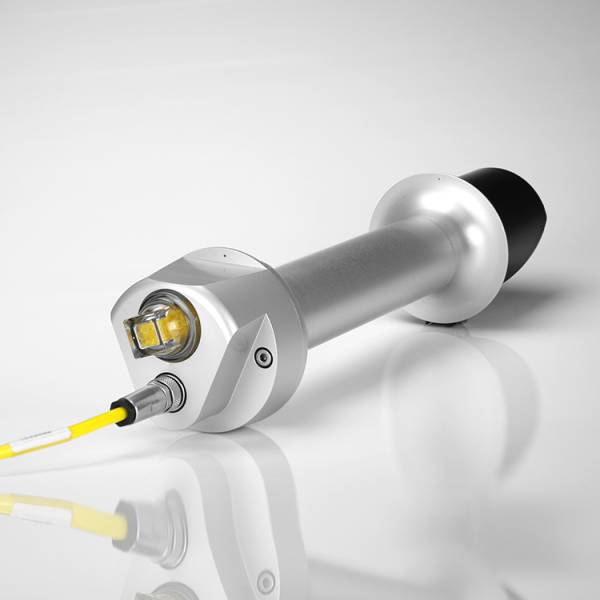€595.00 * (6% Saved)
* Prices incl. VAT plus shipping costs
Delivery time 14 Workdays
- Order number: 10.15.01.02.
CHP1 Pyrheliometer
The sun irradiates the upper earth atmosphere with an average intensity of 1367 W / m². During the passage through the atmosphere, this radiation is absorbed and scattered. This causes different radiation components to reach the Earth's surface. The direct component is a straight line ray from the sun, while the diffuse component comes from all directions due to scattering through the atmosphere.
A pyrheliometer is an instrument specially designed to measure direct sunlight and a 5 ° limited field of view. This is achieved by the shape of the collimating tube, by means of precision screens and by the detector element.
The front aperture is provided with a quartz window, which protects the device and transmits as a filter solar radiation only in the wavelength range from 200 nm to 4000 nm. The CHP1 is equipped with a rain protection cover and integrated adjustment aids.
Each CHP1 Pyrheliometer is equipped with a Pt-100 as well as a 10K thermistor as standard, so that the individual temperature characteristics can be taken into account. The connector on the signal cable and the drying cartridge for screwing in facilitate the installation and maintenance of the instrument considerably.
Its specifications exceed the ISO and WMO performance requirements for instruments with "First Class" classification. Each CHP1 is supplied with a calibration certificate which can be traced back to the WMO (world radiation reference).
The CHP1 pyrrolometer surpasses the requirements for high-end solar radiation networks, such as the Baseline Surface Radiation Network (BSRN). These networks require the most accurate long-term measurements to study climatic changes.
The "renewable energies" industry sector provides similar requirements. For the investigation of photovoltaic systems and materials precise data about the solar radiation are needed. For example, the amount of energy arriving over the period of one year is a decisive factor in the selection of suitable sites for solar parks.
A pyrheliometer must always be directed to the sun so that the sun is always directly above its field of view. The Kipp & Zonen tracking systems (SOLYS 2 and 2AP) guarantee that the CHP1 pyrheliometer is always correctly aligned for the measurement of the direct radiation.
SHP1 Pyrheliometer
The sun irradiates the upper earth atmosphere with an average intensity of 1367 W / m². During the passage through the atmosphere, this radiation is absorbed and scattered. This causes different radiation components to reach the Earth's surface. The direct component is a straight line ray from the sun, while the diffuse component comes from all directions due to scattering through the atmosphere.
The combination of the CHP1 sensor technology with a smart interface makes the SHP1 the currently best pyrheliometer in its class.
The smart interface not only has a wide range of outputs, but an integrated temperature sensor and digital polynomial functions correct the temperature dependence of the detector element for the range -40 ° C to +70 ° C. The response time has been improved and the output has been standardized so that the devices can be interchanged during recalibration. Thanks to the Modbus® protocol, detailed information on instrument status and configuration is available with selection options.
SHP1 Pyrheliometers have an extremely low power consumption, so that a heating of the sensor does not influence the detector power. They work with a wide voltage range and are ideal for use in critical applications. All inputs and outputs are polarity protected and protected against overvoltage and short circuits.
The SHP1 Pyrheliometer is available in two versions, one with analogue output 0 - 1 V, the other with 4 - 20 mA. Both have a 2-wire RS-485 interface with Modbus® (RTU) protocol.
The analog output can be easily connected to almost any data logger or to current-sensitive mV inputs. The Modbus® communicates directly with RTU's, PLC's, SCADA systems, industrial networks and data acquisition systems. A recalibrated instrument retains its analog and digital calibration values, which saves the data acquisition system. The SHP1 is supplied with a comprehensive, traceable calibration certificate.
Each SHP1 Pyrheliometer is equipped with a 10 m cable as standard. The connector on the signal cable and the drying cartridge for screwing in facilitate the installation and maintenance of the instrument considerably.
The SHP1 pyrheliometer surpasses the requirements for high-end solar radiation networks, such as the Baseline Surface Radiation Network (BSRN).
| Sensor Type: | CHP1, Pyrheliometer, SHP1 |
| Norm: | VDI 3786 Part 5 Radiation Measurement |
| Norm - WMO: | WMO-No,8 7th Edition Part I Chapter 7 Measurement of radiation |
| Manufacturer: | Kipp & Zonen |
| Application: | Agriculture, climate measurements, Environmental Protection, Research, Solar technology, Synoptic |
| Measurement methods: | thermopile |
| Spectral range [nm]: | 200...4000 nm |
| max. Spectral sensitivity [nm]: | 380 ... 2500 |
| Sensitivity [µV / W / m²]: | 7 … 14 |
| response time [t95 s]: | < 5 s |
| Zero offset [W / m²]: | < 1 |
| voltage supply: | 6 ... 24 VDC, keine |
| Output signal : | 0 .. 20 mA, 4 ... 20 mA, 10 bis 20 mV bei 1400 W/m² |
| Output signal digital: | Modbus-RTU, RS 485 |
| Degree of protection: | IP65 |
| Mobile data capture radiation:: | handheld device, Multichannel datalogger, Single channel data logger |















